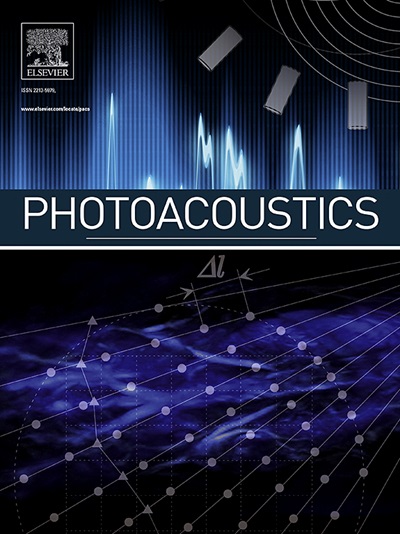层状晶体的光声光谱学:光声信号的增强及其从发热角度的分析
IF 7.1
1区 医学
Q1 ENGINEERING, BIOMEDICAL
引用次数: 0
摘要
光声光谱学是研究半导体和确定其某些基本特性的有力工具。然而,对于所研究的样品来说,产生足够大的信号仍然具有挑战性。为了解决这个问题,重点是以一种不复杂的方式增强光声(PA)信号强度,这种方式不需要改变实验装置的任何部分。增强 PA 信号强度主要是通过操作样品体积及其周围环境来实现的。MoS2 是一种属于范德华晶体的层状材料,由于易于剥离到适当的厚度,因此被选中。将 MoS2 的厚度从 112 微米减少到 7 微米,可使 PA 信号增强 50 倍。我们提出了一个简单的模型来描述基于热过程的结果。此外,还介绍了一种通过 PA 测量确定过渡金属二卤化物能隙的方法。本文章由计算机程序翻译,如有差异,请以英文原文为准。
Photoacoustic spectroscopy of layered crystals: An enhancement of the photoacoustic signal and its analysis from the perspective of heat generation
Photoacoustic spectroscopy is a powerful tool for investigating semiconductors and determining some of their basic properties. However, generating a signal that is large enough for the investigated samples is still challenging. To address this, the focus is on enhancing photoacoustic (PA) signal intensity in a non-complex way, which does not require changing any part of an experimental setup. The PA signal intensity enhancement is mainly achieved by manipulating the sample volume and its surroundings. MoS2, a layered material that belongs to the van der Waals crystals was selected due to ease of exfoliation to the proper thickness. A reduction in MoS2 thickness from 112 to 7 µm, resulted in enhancement of the PA signal by a factor of ∼50. A simple model has been proposed to describe the results based on thermal processes. Additionally, a method to determine the energy gap in transition metal dichalcogenides from PA measurements is presented.
求助全文
通过发布文献求助,成功后即可免费获取论文全文。
去求助
来源期刊

Photoacoustics
Physics and Astronomy-Atomic and Molecular Physics, and Optics
CiteScore
11.40
自引率
16.50%
发文量
96
审稿时长
53 days
期刊介绍:
The open access Photoacoustics journal (PACS) aims to publish original research and review contributions in the field of photoacoustics-optoacoustics-thermoacoustics. This field utilizes acoustical and ultrasonic phenomena excited by electromagnetic radiation for the detection, visualization, and characterization of various materials and biological tissues, including living organisms.
Recent advancements in laser technologies, ultrasound detection approaches, inverse theory, and fast reconstruction algorithms have greatly supported the rapid progress in this field. The unique contrast provided by molecular absorption in photoacoustic-optoacoustic-thermoacoustic methods has allowed for addressing unmet biological and medical needs such as pre-clinical research, clinical imaging of vasculature, tissue and disease physiology, drug efficacy, surgery guidance, and therapy monitoring.
Applications of this field encompass a wide range of medical imaging and sensing applications, including cancer, vascular diseases, brain neurophysiology, ophthalmology, and diabetes. Moreover, photoacoustics-optoacoustics-thermoacoustics is a multidisciplinary field, with contributions from chemistry and nanotechnology, where novel materials such as biodegradable nanoparticles, organic dyes, targeted agents, theranostic probes, and genetically expressed markers are being actively developed.
These advanced materials have significantly improved the signal-to-noise ratio and tissue contrast in photoacoustic methods.
 求助内容:
求助内容: 应助结果提醒方式:
应助结果提醒方式:


